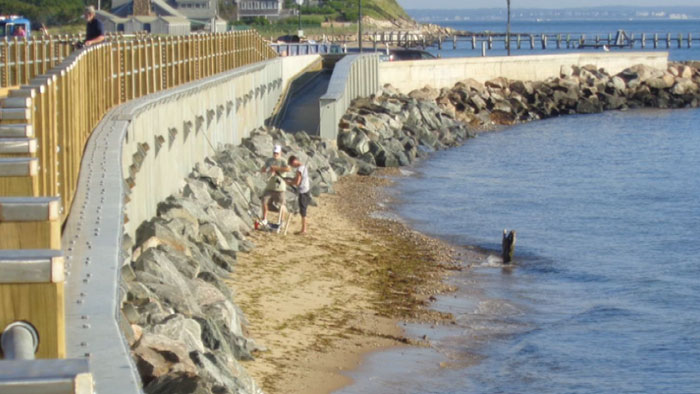Courtesy of U.S. Army Corps of Engineers
A seawall similar to this one at Martha’s Vineyard is one of the options.
By Michael V. Cusenza
The U.S. Army Corps of Engineers is currently mulling a handful of different plans that each feature measures to manage future flood risk in ways that support the long-term resilience and sustainability of the N.Y.-N.J. coastal ecosystem and surrounding communities, and reduce the economic costs and risks associated with flood and storm events such as Superstorm Sandy.
Earlier this month, USACE organized five public scoping meetings in Manhattan and parts of New Jersey to present these plans as part the New York-New Jersey Harbor and Tributaries Coastal Storm Risk Management Feasibility Study.
The study area (New York-New Jersey Harbor and Tributaries) covers 2,150+ square miles and 900+ miles of affected shoreline; 25 counties in N.Y. and N.J.; affected population of approximately 16 million people, including New York City and the six most populated cities in Jersey.
Federal interest in the study, which is also sponsored by the New Jersey Department of Environmental Protection and New York State Department of Environmental Conservation, in partnership with the City of New York, is spurred by: 60 Superstorm Sandy fatalities; recurring impacts from coastal flooding has resulted in significant economic, environmental, and community impacts; $15.7 billion federal investment in post-Sandy recovery and resilience projects; critical infrastructure: three major airports, fivemajor rail systems, largest port on east coast, largest refined petroleum port in U.S., hospitals, police, fire, evacuation routes, rail/subway infrastructure; includes NYC metropolitan area, with a gross metropolitan product of more than $1.66 trillion.
Planning objectives: reduce the risk of coastal storm damage to communities, critical infrastructure, important societal resources, and the environment; improve the community’s ability to recover from damages caused by storm surges by reducing the duration of interruption in services provided by man-made and natural systems; enhance human health and safety by improving the performance of critical infrastructure and natural features during and after coastal storms; restore natural coastal features that have ability to reduce coastal storm risk for communities and ecosystems.
The Army Corps noted that all alternatives/plans will be combinations of structural and nonstructural measures, and natural and nature-based features:
• Alternative 1: No Action
• Alternative 2: N.Y./N.J. Outer Harbor Barrier
• Alternative 3A/3B: Multiple Barriers and Floodwalls & Levee Systems
• Alternative 4: Solitary Bay and River Basin Barriers, Floodwalls & Levees
• Alternative 5: Perimeter Only
The USACE pointed out that the goal of the study is to make a specific recommendation for managing coastal storm flood risk in the NYNJHAT area using a comprehensive systems approach. The recommendation must be determined to be feasible through the USACE planning and environmental review process.
For more information, visit nan.usace.army.mil.

